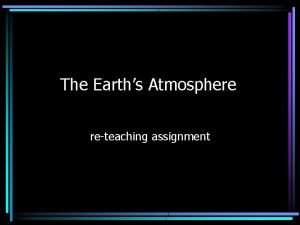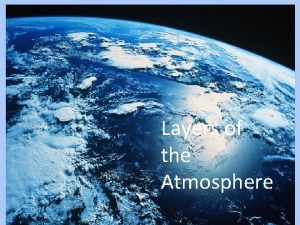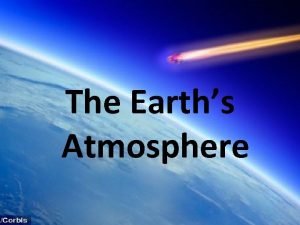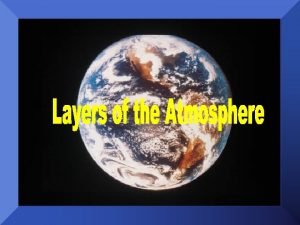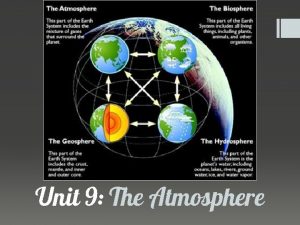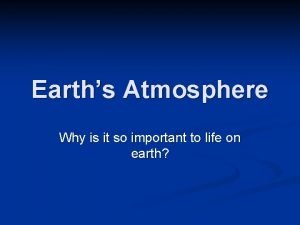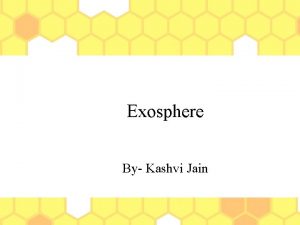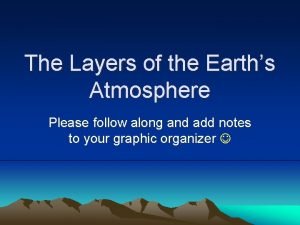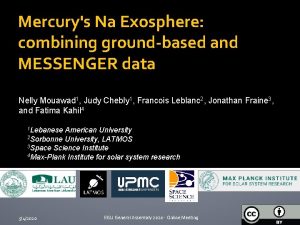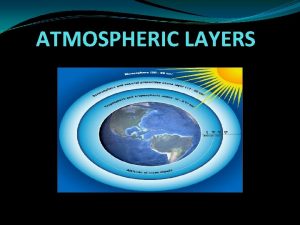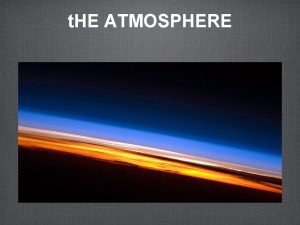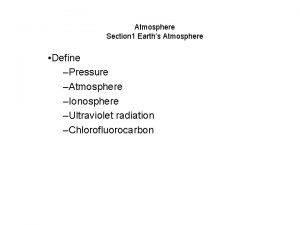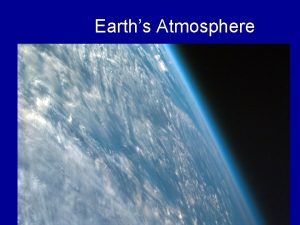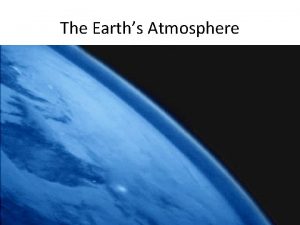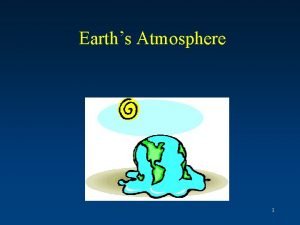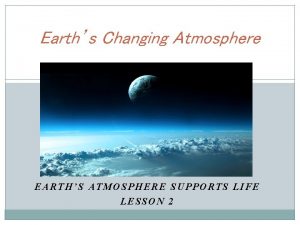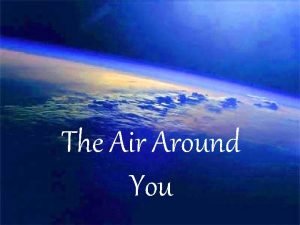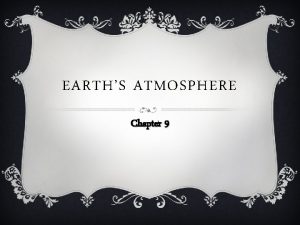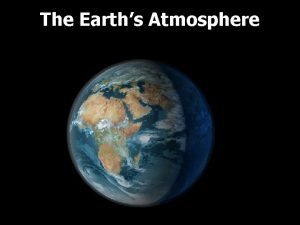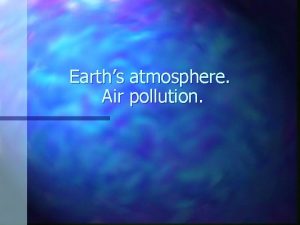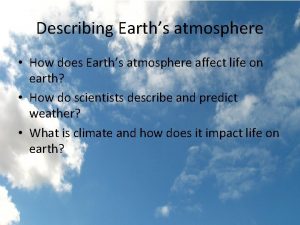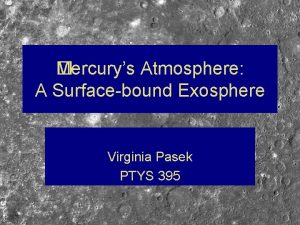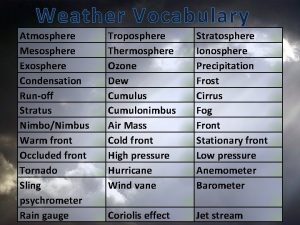Profile of the Earths atmosphere Atmospheric profile Exosphere


















- Slides: 18

Profile of the Earth’s atmosphere

Atmospheric profile • • Exosphere – From 500– 1, 000 km (310– 620 mi; 1, 600, 000– 3, 300, 000 ft) up to 10, 000 km (6, 200 mi; 33, 000 ft), contain free-moving particles that may migrate into and out of the magnetosphere or the solar wind. Exobase – Also known as the 'critical level', it is the lower boundary of the exosphere. Ionosphere – The part of the atmosphere that is ionized by solar radiation stretches from 50 to 1, 000 km (31 to 620 mi; 160, 000 to 3, 300, 000 ft) and typically overlaps both the exosphere and thermosphere. It plays an important part in atmospheric electricity and forms the inner edge of the magnetosphere. Because of its charged particles, it has practical importance because it influences, for example, radio propagation on the Earth. It is responsible for auroras. Thermopause – The boundary above thermosphere, it varies in height from 500– 1, 000 km (310– 620 mi; 1, 600, 000– 3, 300, 000 ft).

Atmospheric profile • • • Thermosphere – From 80– 85 km (50– 53 mi; 260, 000– 280, 000 ft) to over 640 km (400 mi; 2, 100, 000 ft), temperature increasing with height. Although the temperature can rise to 1, 500 °C (2, 730 °F), a person would not feel warm because of the extremely low pressure. The International Space Station orbits in this layer, between 320 and 380 km (200 and 240 mi). Mesopause – The temperature minimum at the boundary between thermosphere and the mesosphere. It is the coldest place on Earth, with a temperature of − 100 °C (− 148. 0 °F; 173. 1 K). Mesosphere – From the Greek word meaning middle. The mesosphere extends from about 50 km (31 mi; 160, 000 ft) to the range of 80– 85 km (50– 53 mi; 260, 000– 280, 000 ft). Temperature decreases with height, reaching − 100 °C (− 148. 0 °F; 173. 1 K) in the upper mesosphere. This is also where most meteors burn up when entering the atmosphere.

Atmospheric profile • • • Stratopause The boundary between the mesosphere and the stratosphere, typically 50 to 55 Stratosphere – From the Latin word "stratus" meaning spreading out. The stratosphere extends from the troposphere's 7– 17 km (4. 3– 11 mi; 23, 000– 56, 000 ft) range to about 51 km (32 mi; 170, 000 ft). Temperature increases with height. The stratosphere contains the ozone layer, the part of the Earth's atmosphere which contains relatively high concentrations of ozone. It is mainly located in the lower portion of the stratosphere from approximately 15– 35 km above Earth's surface, though the thickness varies seasonally and geographically. Ozone Layer – Though part of the Stratosphere, the ozone layer is considered as a layer of the Earth's atmosphere in itself because its physical and chemical composition is far different from the Stratosphere. Ozone (O 3) in the Earth's stratosphere is created by ultraviolet light striking oxygen molecules containing two oxygen atoms (O 2), splitting them into individual oxygen atoms (atomic oxygen); the atomic oxygen then combines with unbroken O 2 to create O 3 is unstable (although, in the stratosphere, long-lived) and when ultraviolet light hits ozone it splits into a molecule of O 2 and an atom of atomic oxygen, a continuing process called the ozone-oxygen cycle. This occurs in the ozone layer, the region from about 10 to 50 km (33, 000 to 160, 000 ft) above Earth's surface. About 90% of the ozone in our atmosphere is contained in the stratosphere.

Atmospheric profile • • • Tropopause – The boundary between the stratosphere and troposphere. Troposphere – From the Greek word meaning to turn or change. The troposphere is the lowest layer of the atmosphere; it begins at the surface and extends to between 7 km (23, 000 ft) at the poles and 17 km (56, 000 ft) at the equator, with some variation due to weather factors. The troposphere contains roughly 80% of the total mass of the atmosphere. Fifty percent of the total mass of the atmosphere is located in the lower 5. 6 km (18, 000 ft) of the troposphere. The average temperature of the atmosphere at the surface of Earth is 20 °C (68 °F; 293 K). [1][2]

Thermal inversions and smog • The temperature of the atmosphere decreases up to about 10, 000 ft • So warm air will naturally rise, including warm polluted air. Which means pollution from cars and factories should rise up into the atmosphere and be disperse where it causes no immediate effects on people • Unless a condition occurs which inhibits the upward movement of warm air

Adiabatic Lapse rate • The name given to the temperature-altitude relationship in the lower atmosphere – Adiabatic means no energy is gained or loss by a volume of gas – Lapse means the temperature decreases with increasing altitude • So warm air will rise and cool at a specific rate. It will not exchange energy with the surrounding air and will expand because the air pressure surrounding it decreases as it rises.

ALR and inversions • Now what happens if the meteorological conditions change the temperature height profile? • If the temperature decrease faster with height than the ALR, then warm air rises indefinitely in to the atmosphere. This provides good mixing and naturally removes pollutants. • If the temperature increases with height, warm air and the pollution in it is trapped near the surface. This is called a temperature inversion. • Pollutants are trapped near the surface-causes smog

SMOG • Smoky Fog • First coined by Dr. Henry Antoine Des Voeux in his 1905 paper, "Fog and Smoke”, in which he was describing the fog seen in London, which had different properties than the fog seen in the English countryside. • Classic smog-primarily composed of particulates and sulfur oxides from coal burning-London famous for its thick smogs or peasoupers as they are called. • Immortalized in literature and art

Smog • Photochemical smog-more modern fog, results from the interaction of the sun and automobile emissions. • Mixture includes: – Carbon monoxide – nitrogen oxides, such as nitrogen dioxide – tropospheric ozone – volatile organic compounds (VOCs) – peroxyacyl nitrates (PAN) – aldehydes (R'O)

Carbon monoxide • Most serious of all the pollutants • Formed from the incomplete combustion of carbon • Prime source is the gasoline fuel internal combustion engine • Dangerous gas-colorless and ordorless • It combines with hemoglobin in the bloodstream – Hemoglobin is a protein in the bloodstream that carries oxygen from the lungs to tissues • CO is more likely to combines with hemoglobin than oxygen, so when it gets in the blood stream it inhibits oxygen flow • Causes suffocation

Concentration and exposure • • • Like many pollutants, the effect of CO on a person is a function of both the concentration and exposure level Concentration is describe by ppm- parts per million PPM-Denotes one part per 1, 000 parts, one part in 106, and a value of 1 × 10– 6. This is equivalent to one drop of water diluted into 50 liters (roughly the fuel tank capacity of a compact car), or one second of time in approximately 11½ days. These are units of proportionality So for CO, after 10 hours – 100 ppm you have a headaches and are unable to think clearly – 300 ppm nausea and loss of consciousness – 600 ppm death • • If the concentration is 1000 ppm, loss of consciousness occurs in about 1 hours and death in 4 Not just a problem from cars, CO is also released in in home gas appliances – Poses an increasing danger as homes are becoming more environmentally sealed to save energy – Gas appliances need proper ventilation

Controls on CO and other emissions • Environmental Protection Agency – Government agency that sets air quality standards • Standards are called the National Ambient Air Quality Standards (NAAQS) • Set by the Clean Air Act of 1970, and amended in 1990. • Clear Skies Act-proposed by the Bush administration in 2003 not passed – Attempt to limit sulfur dioxide, nitrogen oxide and mercury emissions from power plants – Criticized as weakening the clean air act by: • Weakens the current cap on nitrogen oxide pollution levels from 1. 25 million tons to 2. 1 million tons, allowing 68 % more NOx pollution. • Delays the improvement of sulfur dioxide (SO 2) pollution levels compared to the Clean Air Act requirements. • Delays enforcement of smog-and-soot pollution standards until 2015.

Other pollutants: Nitrogen oxides • Reddish brown gas that is responsible for the color of smog • Produced in internal combustion engines and coal plants • Can react with water vapor to produce nitric acid-leads to acid rain (we will come back to this) • Nitrogen dioxide reacts with sunlight to produce nitrogen oxide and oxygen • This oxygen reactions with molecular oxygen to produce ozone • This ozone can react with nitrogen oxide and produce nitrogen dioxide and molecular oxygen • At 0. 5 ppm it can be smelled, 5 ppm it effects the respiratory system, 20 -50 ppm lung liver and heart damage can occur

Other pollutants-hydrocarbons • Recall hydrocarbons are compounds made of carbon and hydrogen • Released into the atmosphere via: – Auto exhaust – Evaporation of gasoline in the process of its refinement, productions and handling – Chemical manufacturing – Manufacturing of dry cleaning fluids, ink and paint manufacturing releases organic solvents – Industrial dryers, ovens and incineration of materials • Hydrocarbons combine with ozone (formed from the nitrogen dioxide) to form complex molecules of hydrogen, oxygen and carbon called peroxyacyl nitrates or PANs.

Effects of Photochemical smog • PANs result in eye irritation, damage to vegetation and skin cancer • Aggravates respiratory conditions • Suggestions that is results in lung cancer and pulmonary disease • Plant diseases – Smog injury-cells on the upper part of the leaf collapse. The leaf looks water soaked – Grape stipple-blotched appearance of leaves, particularly tobacco or grape leaves • Oxidants cause cracking and disintegration of stretched rubber, paints and fabrics loose their color and strength • Visibility issues

Sulfur dioxide • Colorless, nonflammable gas • Produced in the burning of fossil fuels – Coal and oil burning plants – Smelting operations • Natural sources include decay of organic matter • There are natural processes that remove it from the atmosphere, these include dry deposition (random air motions deposit the sulfur on the ground) , plant uptake and precipitation

Effects of sulfur dioxide Respiratory illness-including lung cancer Cardiovascular illness Marble, limestone and mortar dissolved Protective coatings on metal loose their protective ability • Plant damage • Note-effects are hard to distinguish from the effects of sulfuric acid, but the sulfur dioxide helps to form sulfuric acid in the environment • •
 Earths early atmosphere contained
Earths early atmosphere contained Exosphere
Exosphere Layer closest to earth
Layer closest to earth Exosphere
Exosphere Exosphere temp
Exosphere temp Exosphere
Exosphere How many layers in atmosphere
How many layers in atmosphere Fun facts about exosphere
Fun facts about exosphere Exosphere
Exosphere Exosphere
Exosphere Why is the troposphere important
Why is the troposphere important Earths biomes
Earths biomes Whats earths moon called
Whats earths moon called Earths interior
Earths interior What shape is the earths orbit
What shape is the earths orbit Earths orbit seasons
Earths orbit seasons The earth's layers foldable
The earth's layers foldable Earths 4 spheres
Earths 4 spheres Whats the name of earths moon
Whats the name of earths moon

